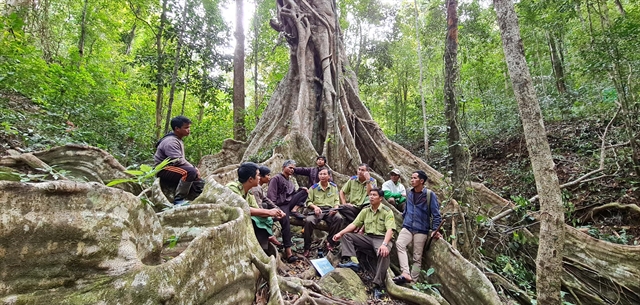Inside the UNESCO-recognised biosphere reserve, rangers are still working hard to protect its rich resources.

Rangers and local people in charge of protecting the Kon Ka Kinh National Park. — VNA/VNS Photo Hong Diep
But as the plateau spans across more than 413,500 hectares, it's no easy task.
For nearly two decades, Chui of Mang Yang District has been safeguarding his allocated land in Kon Ka Kinh National Park.
Joining forces with the officers since 2004, he is one of the local ethnic people assigned to protect different parts of the forest, and receive compensation for their work.
However, the large area and limited human resources mean patrols are often difficult, even dangerous.
Chui said: “Due to the treacherous terrain and steep hills, it is difficult to move around here. There have been days where our motorbikes broke down and we could only haul them back.
“The weather here is also quite harsh, especially during rainy seasons, so patrols are not easy.”
The Kon Ha Nung Plateau, which received UNESCO recognition in September last year, consists of the 57,589-hectare Kon Ka Kinh National Park and Kon Chu Rang Nature Reserve, plus the 152,009-hectare buffer zone, and the 206,211-hectare transition zone.
The biosphere reserve is home to a rich and diverse array of fauna and flora, including several endangered species and rare plants of high economic value – often a target of aggressive poachers.
Chief ranger Tran Van Thu added: “Due to the modest number of people in charge of a vast area, our management capacity is quite limited, and supporting tools are also minimal.”
All of that means poachers have nothing to fear, he said. Hard work coupled with modest compensation also fails to attract more people to join the forces.
Gung, a Bahnar ethnic who is also in charge of protecting an area in the forest, added: “Protecting the forest is protecting our life.
“It is fighting against climate change, as well as raising people’s awareness against causing harm to the forest and wildlife in this area.”
Acknowledging the problems, authorities have been introducing new initiatives to improve the situation.
Nguyen Hong Quan, deputy director of Kon Chu Rang Nature Reserve said: “We plan to collaborate with the Ministry of Health, and HCM City Institute of Drug Quality Control, to preserve and develop several special medicinal plants in the Kon Chu Rang Reserve.”
Meanwhile, various organisations and individuals have been mobilised to invest in ecotourism. These are a few of the approaches that aim to improve the compensation for the staff at the reserve, and the community's livelihood.
As one of the two core zones, Kon Ka Kinh National Park has been actively promoting its unique values in biodiversity and preservation, as well as the unique culture of different ethnic groups in the area.
The plateau’s UNESCO recognition in September is seen as a major opportunity to develop ecotourism and economic models towards green growth, which is expected to turn the area into an attractive destination in the future.
According to the deputy chairman of Gia Lai People’s Committee Kpa Thuyen, the goal is to create a sustainable socio-economic development model in the area.
They also aim to form a harmonious connection between the local biodiversity and the ethnic cultural identities, and between economic development and environmental protection.
Nguyen Van Hoan, deputy director Gia Lai Department of Agriculture and Rural Development said: “Gia Lai Province needs to develop plans and activities, in order to form a framework for collaboration and management – in terms of sustainable preservation and management at the biosphere reserve.
“The province must also mobilise and approach international and national resources to realise projects, programmes and activities related to sustainability in this area.”
It is crucial to raise people’s awareness, to educate and encourage preservation and development, he added.